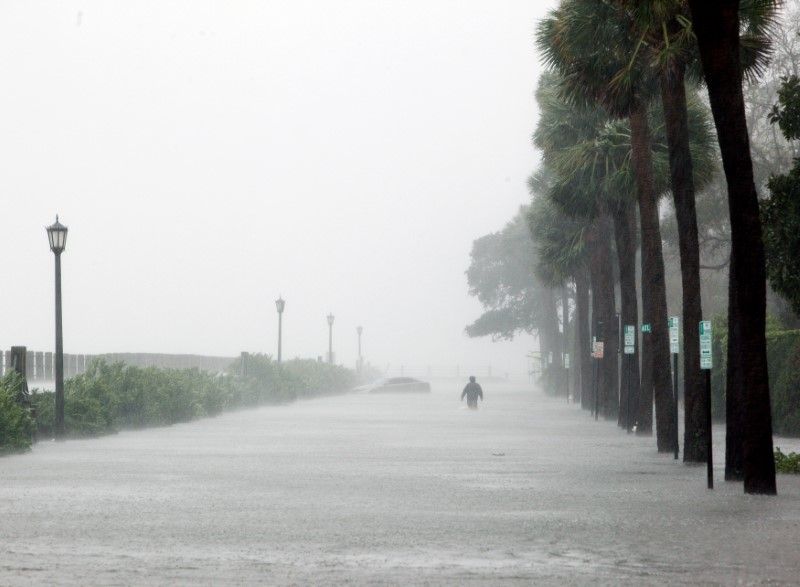
Hurricane Matthew slammed into South Carolina on Saturday, packing a diminished yet still powerful punch after killing almost 900 people in Haiti and causing major flooding and widespread power outages as it skirted Florida and Georgia.
Now weakened, the most powerful Atlantic storm since 2007 left flooding and wind damage in Florida before moving slowly north to soak coastal Georgia and the Carolinas. Wind speeds had dropped by nearly half from their peak about a week ago to 75 miles per hour (120 kph), reducing it to a Category 1 hurricane, the weakest on the Saffir-Simpson scale of 1 to 5.
Matthew, which topped out as a ferocious Category 5 storm more than a week ago, made landfall near McClellanville, a village 30 miles (48 km) north of Charleston that was devastated by a Category 4 hurricane in 1989. The National Hurricane Service said Matthew was over Myrtle Beach, South Carolina, on Saturday afternoon, and warned of potentially life-threatening flooding in Georgia and North Carolina even as the storm slowed as it plowed inland.
At least five deaths in Florida and three deaths in North Carolina were attributed to the storm. Two people were killed by falling trees in Georgia's Bulloch County, the county coroner said. The storm knocked out power to almost 1.6 million households and businesses in the U.S. Southeast.
The stretch of the Atlantic coast from Miami to Charleston, a nearly 600-mile drive, encompasses some of the most well-known beaches, resorts and historical towns in the southeastern United States. Parts of Interstate 95, the main north-south thoroughfare on the East Coast, were closed due to flooding and fallen trees, state officials said.
In Florida, 775,000 were without power, according to state utilities, while in South Carolina 433,000 had no electricity, Governor Nikki Haley said. Georgia Power said at least 275,000 were without power in the state. Roads in Jackson Beach, Florida, were littered with wood, including sections of a historic pier, and foot-deep, water-clogged intersections. Beachfront businesses suffered moderate damage.
"We rode out the storm. It wasn't this bad at our house, but here there's a lot of damage," said Zowi Cuartas, 18, as he watched people pick up shattered signs near the beach. "We were prepared to lose our house."
Governor Rick Scott of Florida said more than 6,000 people stayed in shelters overnight, but he appeared relieved at a news conference on Saturday the storm had not done more harm.
"We're all blessed that Matthew stayed off our coast," he said. He predicted most people would have power back by Sunday evening. He did not comment on the death reports, which were confirmed by local officials.
Streets in downtown Charleston, known for its historic architecture, were flooding up to the tops of tires on some cars and a few residents waded near the city's sea wall as high tide approached.
Tony Williams, 54, who said he is homeless, rode his bicycle against huge wind gusts after spending the night in the garage of a bank. "I just got tired of laying where I was laying," he said.
On Daufuskie Island near the Georgia border, writer Roger Pinckney, 70, said he was fine on Saturday morning after refusing pleas from officials for residents of low-lying barrier islands to evacuate. "It blew like hell," he said.
Charleston officials said they were not aware of any deaths, injuries or significant structural damage. Winds and the threat of surges were expected to diminish through the day.
Floods Likely in North Carolina
In North Carolina, where the hurricane was due to arrive on Saturday evening, Governor Pat McCrory warned storm surges and high winds could cause serious problems. He said he was "extremely concerned" the downgrade to a Category 1 would cause people not to take warnings seriously.
Forecasters warned of flooding as 15 inches (40 cm) of rain were expected to fall in some areas along with massive storm surges and high tides. Further south, some 8 inches (20 cm) of rain fell in the Savannah, Georgia, area, downing trees and causing flooding.
The National Weather Service said record-high tides were recorded at the Savannah River at the South Carolina-Georgia border, peaking at 12.6 feet, surpassing those caused by Hurricane David in 1979.
Though gradually weakening, Matthew was forecast to remain a hurricane until it begins moving away on Sunday, the NHC said.
Uncommon Knowledge
Newsweek is committed to challenging conventional wisdom and finding connections in the search for common ground.
Newsweek is committed to challenging conventional wisdom and finding connections in the search for common ground.
About the writer
To read how Newsweek uses AI as a newsroom tool, Click here.








